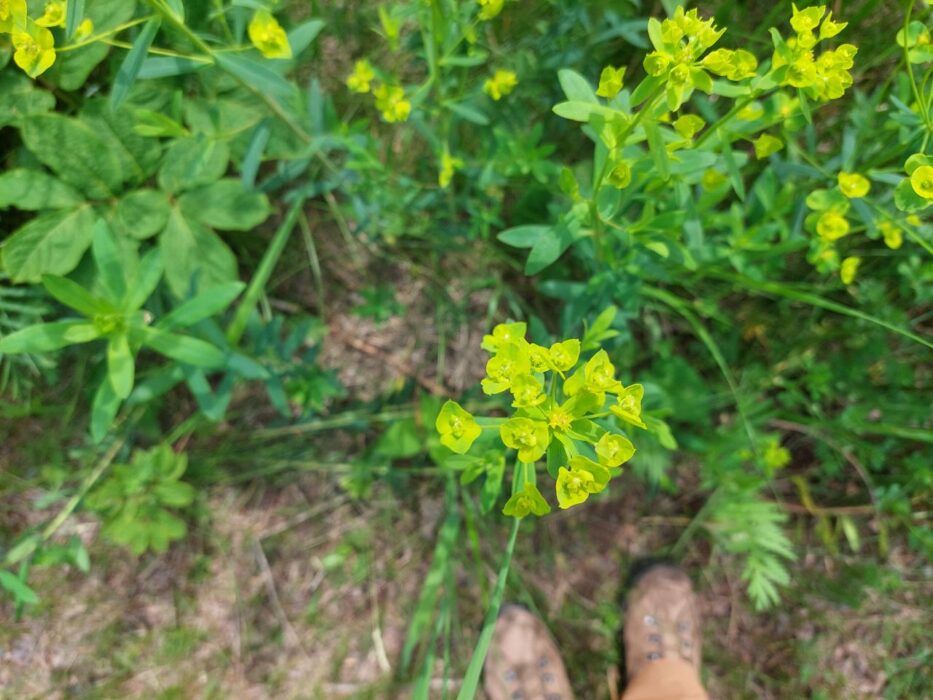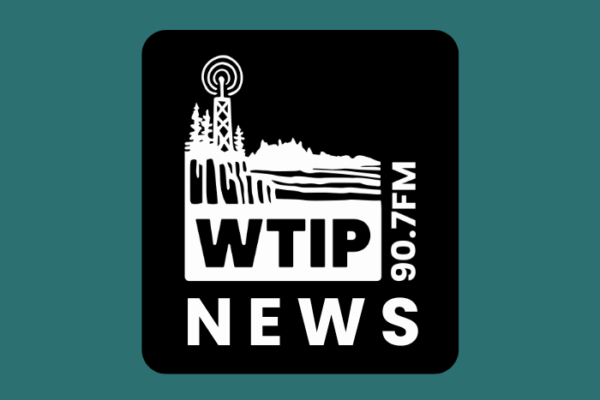Cook County Invasives team works with National Forest Service to address leafy spurge in the BWCAW
On a very buggy day at the end of June, a small crew of four from the Cook County Highway Department, led by Agriculture Inspector Tia Parks, loaded up in a couple of canoes and headed into the Boundary Waters.
The purpose of the trip was to check on a campsite just inside the wilderness that is one of the only known sites of leafy spurge in the county.
Leafy spurge is an invasive species, and the only other site where it has been documented in recent years is in Tofte. This site in the Boundary Waters is one that the National Forest Service (NFS) has been monitoring for some time. More recently, the NFS has worked with the county invasives team to manage some sites within the BWCAW. This is where Parks and her team come in.
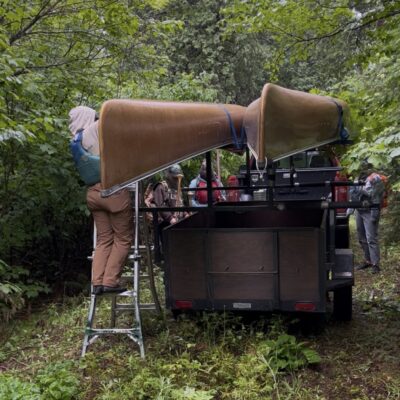
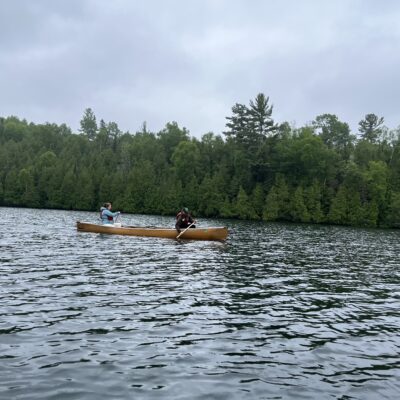
Though Parks’ role as Agriculture Inspector is based in the Cook County Highway Department, as leader of the Invasives Teams, her work can extend beyond managing terrestrial invasives on county land. She has been able to work with local land owners, as well as being part of invasives management efforts on public lands, including some state and federal lands.
She said, “This is a partnership with the US Forest Service, so we get some of the closer infestations in the Boundary Waters. We’ve started doing that over the last two years. Last year we did a purple loosestrife paddle up around Saganaga, Seagull, and Alpine lakes, and that went over really well. So we’re just taking on a couple of these sites a year.”
While not common at this time in Cook County, the leafy spurge population in the BWCAW has been present and monitored for years. Leafy spurge can grow up to three feet tall, has lance-shaped, alternating leaves, and are a blue-green color. The plant also has clusters of yellow flowers, which Parks described as “a dead giveaway for spurge.” The small flowers sit above two additional yellow leaves, which look like additional petals.
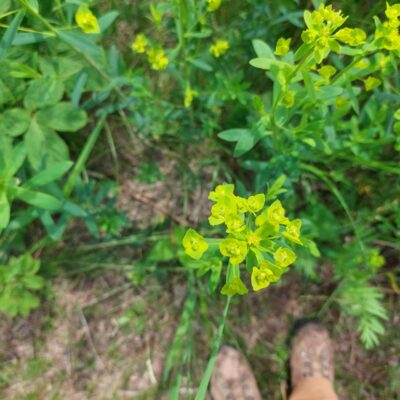
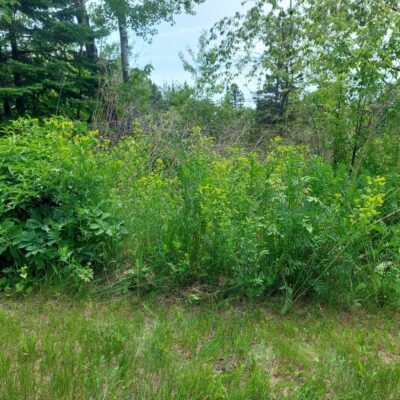
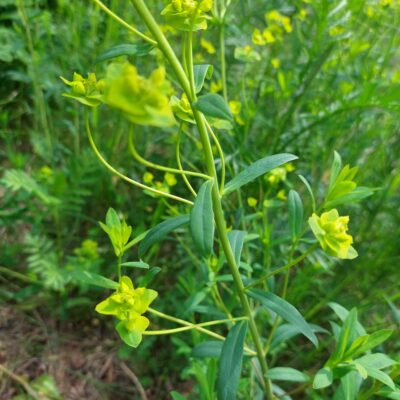
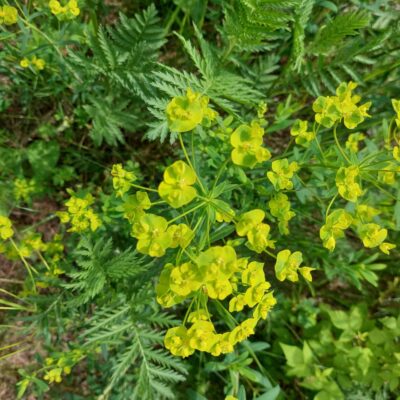
Like most invasives, leafy spurge takes over an area quickly. In addition to its fast spread, leafy spurge can pose management challenges because of a few key characteristics. First, root fragments can sprout into new plants, meaning it requires careful and thorough pulling. Second, the plant spreads seeds effectively. Parks explained, “It can pop open and shoot out at seed about 20 feet, which is quite the distance for a little stationary plant.”
While out in the field removing the plants from the BWCAW, Parks’ team wore gloves and eye protection, because leafy spurge produces a sap that can irritate or burn skin exposed to it.
Parks talked about the management method for this plant in this space. She said that when considering the best way to approach managing or eradicating a particular species, area use and damage to the surrounding environment needs to be considered. Leafy spurge has been successfully managed using a bio-control. That method is most effective in areas where there is a high density of the plant, and the area is infrequently disturbed, making a high-traffic campsite a poor candidate for bio-control.
Leafy spurge can also be managed with an herbicide, but Parks explained that in a space like the BWCAW, where chemicals could easily be spread into the area water, spraying an herbicide requires extra caution. She said that is an option that would require additional conversations with the NFS to create a safe plan of action.
With a site like this one, where, thus far, manual cutting and removal has been the approach, this means taking a longer view of the situation. On that single day in June, Park’s team removed about 60 individual plants. This, according to Parks, is good news.
“The last time that an approximation was made was, I think, 2022 when one of our partners was here pulling they’re from the Forest Service, and they said there was about 100 to 150 plants, approximately, that they pulled,” Parks said. “And someone came back in 2023 and did some pulling. But we didn’t get a head count from that. But you know, it’s been three years since the last approximation and going from 100 to 150 down to 60 only seems pretty good… We’re happy with 60 today.”
Leafy spurge is not the only invasive plant present in the Boundary Waters. Parks said that garlic mustard and purple loosetrife have also been seen in the boundary waters.
While many people who visit the boundary waters each year are concerned about protecting it, invasives move through the BWCAW with human help. Parks pointed to packs and gear moved across the BWCAW as the primary way most invasives are transported. She said giving gear a thorough cleaning before and during a trip can help reduce the spread of seeds.
“Clean off all your gear, your boots, your shoes, whatever you’re wearing,” Parks said. “It’s highly important that you clean those before you go on trails, you go to our lakes, whatever that might be.”
Prevention of further spread is key for managing the invasives, but Parks also talked about what campers and paddlers should do if they see what they believe to be an invasive in the boundary waters. She suggested that instead of trying to address any plants themselves, people should contact either her at the Highway Department, or to reach out to the nearest National Forest Service ranger station when they leave the BWCAW. Both because some plants can cause injury or irritation, and because improper handling can contribute to the spread of some invasives, Parks said the best approach is for those trained in plant management to do any removal.
To report an invasive species, whether in the BWCAW or elsewhere in Cook County, Parks can be reached at tia.parks@co.cook.mn.us, or by phone at 218-387-3692.
WTIP’s Kirsten Wisniewski reported on this effort and spoke with Tia Parks. This story’s audio is below.





